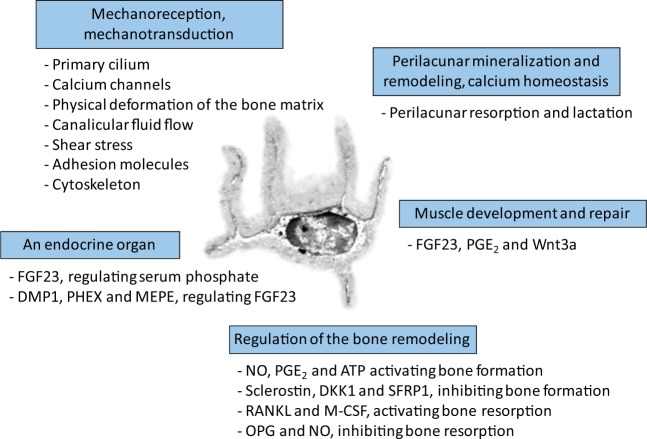Figure 1.
Functions assigned to osteocytes.
The osteocyte has several functions: (a) it senses and integrates mechanical signals (mechanoreception), and converts them into a biological message (mechanotransduction); (b) it directs the differentiation and activity of osteoblasts through the release of NO, PGE2, and ATP that activates bone formation, and sclerostin, DKK1, and SFRP1 that inhibits bone formation; (c) it directs the differentiation and activity of osteoclasts through the secretion of RANKL and M-CSF that activates bone resorption, and OPG and NO that inhibits bone resorption; (d) it controls the local mineralization of the surrounding bone matrix and calcium homeostasis that it can lyse locally to release calcium into the systemic bloodstream during periods of high demand (e.g. lactation); (e) it has an endocrine function by releasing into the bloodstream a specific endocrine factor, FGF23 and its related regulating factors DMP1, PHEX, and MEPE, to modulate phosphate homeostasis; (f) it may modulate the proliferation and tone of skeletal striated muscle cells through the expression of FGF23, PGE2,and Wnt3a. (Adapted with the publisher’s permission from Dallas et al. [2013] and Rochefort and Benhamou [2013].) ATP, adenosine-triphosphate; DKK1, Dickkopf-related protein 1; DMP1, dentin matrix protein 1; FGF23, fibroblast growth factor 23; M-CSF, macrophage-colony stimulating factor; MEPE, matrix extracellular phosphoglycoprotein; NO, nitric oxide; OPG, osteoprotegerin; PGE2, prostaglandin E2; PHEX, phosphate-regulating gene with homologies to endopeptidases on the X chromosome; RANKL, receptor activator of nuclear factor kappa-B ligand; SFRP1, frizzled-related protein 1.

